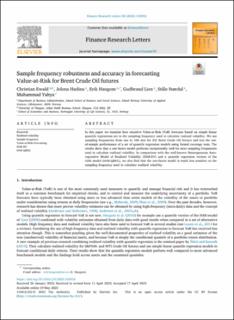| dc.contributor.author | Ewald, Christian Oliver | |
| dc.contributor.author | Hadina, Jelena | |
| dc.contributor.author | Haugom, Erik | |
| dc.contributor.author | Lien, Gudbrand | |
| dc.contributor.author | Størdal, Ståle | |
| dc.contributor.author | Yahya, Muhammad | |
| dc.date.accessioned | 2023-10-06T10:49:58Z | |
| dc.date.available | 2023-10-06T10:49:58Z | |
| dc.date.created | 2023-07-28T22:10:58Z | |
| dc.date.issued | 2023 | |
| dc.identifier.issn | 1544-6123 | |
| dc.identifier.uri | https://hdl.handle.net/11250/3094924 | |
| dc.description.abstract | In this paper we examine how sensitive Value-at-Risk (VaR) forecasts based on simple linear quantile regressions are to the sampling frequency used to calculate realized volatility. We use sampling frequencies from one to 108 min for ICE Brent Crude Oil futures and test the out-of-sample performance of a set of quantile regression models using formal coverage tests. The results show that a one-factor model performs exceptionally well for most sampling frequencies used to calculate realized volatility. In comparison with the well-known Heterogeneous Auto-regressive Model of Realized Volatility (HAR-RV) and a quantile regression version of the HAR model (HAR-QREG), we also find that the one-factor model is much less sensitive to the sampling frequency used to calculate realized volatility. | |
| dc.language.iso | eng | en_US |
| dc.title | Sample frequency robustness and accuracy in forecasting Value-at-Risk for Brent Crude Oil futures | en_US |
| dc.title.alternative | Sample frequency robustness and accuracy in forecasting Value-at-Risk for Brent Crude Oil futures | en_US |
| dc.type | Journal article | en_US |
| dc.type | Peer reviewed | en_US |
| dc.description.version | publishedVersion | |
| dc.description.version | publishedVersion | |
| dc.source.volume | 58 | en_US |
| dc.source.journal | Finance Research Letters | en_US |
| dc.source.issue | A | en_US |
| dc.identifier.doi | 10.1016/j.frl.2023.103916 | |
| dc.identifier.cristin | 2163905 | |
| cristin.ispublished | true | |
| cristin.fulltext | original | |
| cristin.fulltext | original | |
| cristin.qualitycode | 1 | |
